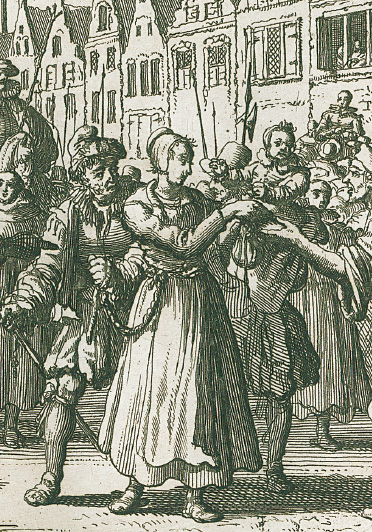A History of Western Society: Printed Page 401
A History of Western Society, Value Edition: Printed Page 410
INDIVIDUALS IN SOCIETY
Anna Jansz of Rotterdam

Anna Jansz (1509–1539) was born into a well-to-do family in the small city of Briel in the Netherlands. She married, and when she was in her early twenties she and her husband came to accept Anabaptism after listening to a traveling preacher. They were baptized in 1534 and became part of a group who believed that God would soon come to bring judgment on the wicked and deliver his true followers. Jansz wrote a hymn conveying these apocalyptic beliefs and foretelling vengeance on those who persecuted Anabaptists: “I hear the Trumpet sounding, From far off I hear her blast!…O murderous seed, what will you do? Offspring of Cain, you put to death The lambs of the Lord, without just cause — It will be doubly repaid to you! Death now comes riding on horseback, We have seen your fate! The sword is passing over the land, With which you will be killed and slain, And you will not escape from Hell!”
Jansz and her husband traveled to England, where she had a child, but in November 1538 she and her infant son, Isaiah, returned to the Netherlands, along with another woman. As the story was later told, the two women were recognized as Anabaptists by another traveler because of songs they were singing, perhaps her “Trumpet Song” among them. They were arrested and interrogated in the city of Rotterdam, and sentenced to death by drowning. The day she was executed — January 24, 1539 — Anna Jansz wrote a long testament to her son, providing him with spiritual advice: “My son, hear the instruction of your mother, and open your ears to hear the words of my mouth. Watch, today I am travelling the path of the Prophets, Apostles, and Martyrs, and drink from the cup from which they have all tasted….But if you hear of the existence of a poor, lowly, cast-out little company, that has been despised and rejected by the World, go join it…. Honor the Lord through the works of your hands. Let the light of Scripture shine in you. Love your Neighbor; with an effusive, passionate heart deal your bread to the hungry.”
Anabaptists later compiled accounts of trials and executions, along with letters and other records, into martyrologies designed to inspire deeper faith. One of the most widely read of these describes Jansz on her way to the execution. She offered a certain amount of money to anyone who would care for her son; a poor baker with six children agreed, and she passed the child to him. The martyrology reports that the baker later became quite wealthy, and that her son, Isaiah, became mayor of the city of Rotterdam. As such, he would have easily been able to read the court records of his mother’s trial.
Anna Jansz was one of thousands of people executed for their religious beliefs in sixteenth-century Europe. A few of these were high-profile individuals such as Thomas More, the Catholic former chancellor of England executed by King Henry VIII, but most were quite ordinary people. Many were women. Women’s and men’s experiences of martyrdom were similar in many ways, but women also confronted additional challenges. Some were pregnant while in prison — execution was delayed until the baby was born — or, like Jansz, had infants with them. They faced procedures of questioning, torture, and execution that brought dishonor as well as pain. Eventually many Anabaptists, as well as others whose religion put them in opposition to their rulers, migrated to parts of Europe that were more tolerant. By the seventeenth century the Netherlands had become one of the most tolerant places in Europe, and Rotterdam was no longer the site of executions for religious reasons.
Source: Quotations are from Elisabeth’s Manly Courage: Testimonials and Songs of Martyred Anabaptist Women in the Low Countries, ed. and trans. Hermina Joldersma and Louis Peter Grijp (Milwaukee: Marquette University Press, 2001).
QUESTIONS FOR ANALYSIS
Question
How did religion, gender, and social class all shape Jansz’s experiences and the writings that she left behind?
Question
Why might Jansz’s hymn and her Anabaptist beliefs have seemed threatening to those who did not share her beliefs?
